-
Recent Posts
- Trump’s “Big Beautiful Bill” Is a Grotesque Giveaway to Fossil Fuel Billionaires While Adding $3.3 Trillion to Nation’s Debt
- Senator Chris Murphy Charges that Trump “Has Opened a Channel for Bribery”
- Congressman Casten: Trump’s Assault on the Rule of Law Is Causing Capital Flight Out of U.S. by Foreign Investors
- Trump’s Approval Rating Drops to 80-Year Low; IMF Says U.S. Tariffs Now Exceed the Highs During the Great Depression
- Nasdaq Has Lost More than 3,000 Points Since Trump’s First Full Day in Office in 2025; the Pain Has Barely Begun
- The Bond Crisis Last Week Was a Global No-Confidence Vote in U. S. President Donald Trump
- Trump’s Tariff Plan Guts $5 Trillion in Stock Value in Two Days; Senator Warren Calls for Emergency Action Before Markets Open on Monday
- Trump’s Attacks on Big Law, Universities, and the Media Have a Common Goal: Silence Dissent Against Authoritarian Rule
- Trump Administration Gives All Clear to Laundering Money through Shell Companies and Bribing Foreign Officials
- Four Megabanks on Wall Street Hold $3.2 Trillion in Uninsured Deposits – Which May Explain Senator Schumer’s Pivot to the GOP to Stop a Government Shutdown
- Here’s What Came Crashing Down Yesterday for Trump’s “Genius” Guy, Elon Musk: Tesla Stock, Access to Twitter (X), His Years of Secret Calls with Putin
- After Banning the Associated Press, Trump Is Now Targeting Specific Journalists That He Wants to See Fired
- Closely Watched Atlanta Fed Model Predicts Negative U.S. Growth in First Quarter
- Trump’s Gangster Diplomacy Makes Front Page Headlines Around the Globe
- Who Benefits Alongside Elon Musk If He Succeeds in Killing the CFPB: the Megabanks on Wall Street that Underwrite His Tesla Stock Offerings
- In Trump 1.0, the State Department Used Taxpayer Money to Publish a Book Elevating Elon Musk to a Superhero; It Was Funded by USAID, the Agency Musk Wants to Quickly Shut Down
- News Host Joy Reid Raises Threat of Trump Selling U.S. to Putin; Ten Days Later Her Show Is Cancelled
- Elon Musk’s DOGE Appears to Be Violating a Court Order; It Has Taken Down Hundreds of YouTube Videos that Educate Americans on How to Avoid Being Swindled
- Barron’s Releases Audio of Jamie Dimon Cursing Out His Workers at a Town Hall, as Dimon Plans to Dump Another One Million JPM Shares
- There’s One Federal Investigative Agency that Neither Trump nor Elon Musk Can Touch: It Just Opened an Investigation into DOGE
- Elon Musk’s Companies Were Under Investigation by Five Inspectors General When the Trump Administration Fired Them and Made Musk the Investigator
- Donald Trump Gives the Greenlight to Goldman Sachs and JPMorgan Chase to Return to Bribing Foreign Officials
- After Tech Geeks Built a Back Door to Loot Billions from FTX, Republicans Refuse to Investigate What Elon Musk’s Tech-Squad Did Inside the U.S. Treasury’s Payment System
- Former Prosecutor, Now U.S. Senator, Informs Tesla That CEO Musk May Be Violating Federal Law and to “Preserve All Records”
- Trump’s Hedge Fund Guy Is Now Overseeing the U.S. Treasury, IRS, OCC, U.S. Mint, FinCEN, F-SOC, and the Consumer Financial Protection Bureau
- As Elon Musk Begins Shutting Down Payments to Federal Contractors, a Strange Money Trail Emerges to His Operatives Inside the U.S. Treasury’s Payment System
- JPMorgan Chase Charged by Yet Another Internal Whistleblower with Cooking the Books
- We Asked Google’s AI Search Model, Gemini, Questions About the Fed and Wall Street Megabanks: It Got the Answers Dead Wrong
- With Trump and Melania’s Crypto Coins Likely to Raise Legal Challenges, Why Didn’t Trump Fire the SEC’s Inspector General in His Purge of IGs?
- Fossil Fuel Industry Could End Up Paying Tens of Billions for LA Wildfires and Deceiving the Public on Climate Change for Decades
- It’s Being Called the Biggest Grift by a President in U.S. History: Trump and First Lady Launch their Own Crypto Coins
- Trump Plans to Install a Fracking CEO to Head the Energy Department and Declare a National Emergency on Energy to Gain Vast Powers
- Fossil Fuel Money Played a Role in the Los Angeles Fires and the Push to Install Pete Hegseth as Secretary of Defense
- When It Comes to Wealth Retention in Retirement, Concrete May Be the New Gold
- Wall Street Watchdog Warns “Clock Is Ticking on a Coming Catastrophic Financial Crash”
- Wall Street Is Sending the Same Message to Americans on Fossil Fuel Financing that It Sent on Cigarettes: Drop Dead
- In a Six-Week Span, this Dark Pool with a Curious Past Traded 3.7 Billion Shares
- Wall Street’s Lobby Firm Hired Eugene Scalia of Gibson Dunn to Sue the Fed for Jamie Dimon
- Postmaster General Louis DeJoy Made $561,051 in Compensation in 2024, as Mail Costs Spiked and Delivery Deteriorated
- Fed Chair Jay Powell Sends a Bold Message to Trump and Tanks the Dow by 1123 Points
- The Head of Fixed Income at T. Rowe Price Makes the Scary Case for the 10-Year Treasury to Spike to 6 Percent
- $663 Billion in Cash Assets Have Gone Poof at the Largest U.S. Banks
- Donald Trump to Ring Bell at New York Stock Exchange Today as Hit List Posters Appear in Manhattan Targeting Wall Street CEOs
- Trump Has a Slush Fund to Prop Up the Dollar – Will He Use It to Prop Up Bitcoin Instead?
- A CEO Assassination; a Billionaire Heiress/NYPD Commissioner; a Secret Wall Street Spy Center – Here’s How They’re Connected
- Despite More than 1600 Tech Scientists Signing a Letter Calling Crypto a Sham, Trump Names a Crypto Cheerleader for SEC Chair
- The Fed Rings a Warning Bell: Hedge Funds and Life Insurers Are Reporting Historic Leverage
- Trump’s Nominee for FBI Director, Kash Patel, Has Businesses Financially Intertwined with Trump
- Donald Trump Is at Risk of Getting Named in a Fossil Fuels Conspiracy Lawsuit
- Trump Is Having Difficulty Getting a Lawyer to Accept the Nomination for SEC Chair: Here’s Why
Search Results for: Jamie Dimon
The Tide Is Going Out and JPMorgan, Deutsche Bank and AIG Appear to Be Swimming (Read Trading) Naked
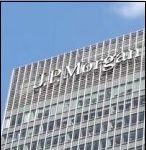
By Pam Martens and Russ Martens: March 29, 2020 ~ Warren Buffett is credited with the quote: “Only when the tide goes out do you discover who’s been swimming naked.” Friday’s closing prices among some of the heavily interconnected mega Wall Street banks and insurance companies known to be counterparties to Wall Street’s derivatives appeared to show who’s swimming naked in the realm of derivatives – naked meaning who has sold derivative protection (gone short the risk) on something that is blowing up. As the chart above shows, the S&P 500 stock index (SPX) closed with a loss of 3.37 percent while the following three stocks closed with more than double that percentage of loss: Deutsche Bank was down by 7.44 percent; JPMorgan shed 7.12 percent while AIG was off by 7.27 percent. When the Federal Reserve needs to create a hodgepodge of secretive Special Purpose Vehicles (SPVs) and run … Continue reading
New York Fed Has Allowed Dangerous Wall Street Banks to Have Lower Loan Loss Reserves than at time of 2008 Crash
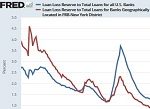
By Pam Martens and Russ Martens: March 27, 2020 ~ The New York Fed supervises four of the most dangerous banks in America: Citigroup, JPMorgan Chase, Goldman Sachs and Morgan Stanley. That opinion is not just ours but is documented by data from federal agencies. All four of these banks own federally-insured commercial banks that are backstopped by the U.S. taxpayer while also gambling in the stock market through their own Dark Pools and in trillions of dollars of derivatives. All four of these banks received tens of billions of dollars in bailout money during the 2007-2010 financial crash, which was brought on by their greed and corrupt activities in the derivatives and subprime market. Citigroup’s losses were of such magnitude that it became insolvent, turned into a 99 cent stock, and yet secretly received the largest bailout in global banking history from the same regulator who had allowed it … Continue reading
JPMorgan Chase and Citibank Have $2.96 Trillion in Exposure to Credit Default Swaps

By Pam Martens and Russ Martens: March 22, 2020 ~ According to the most recent report from the regulator of national banks, the Office of the Comptroller of the Currency (OCC), JPMorgan Chase has exposure to $1.2 trillion in Credit Default Swaps while Citibank has exposure to $1.76 trillion for a combined total of $2.96 trillion as of September 30, 2019. According to the same report, the total exposure to Credit Default Swaps among all national banks in the U.S. is $3.7 trillion – meaning that just these two banks are responsible for 80 percent of that exposure. As of this past Friday, JPMorgan Chase had lost 39.3 percent of its common equity capital in the past five weeks while Citigroup, parent of Citibank, had lost 51.7 percent. That left JPMorgan Chase with just $256.68 billion in market cap versus Citigroup’s meager $79.86 billion. One of our readers emailed us … Continue reading
The Fed Has Pumped $9 Trillion into Wall Street Over the Past Six Months, But Mnuchin Says “This Isn’t Like the Financial Crisis”
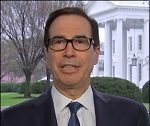
By Pam Martens and Russ Martens: March 14, 2020 ~ On February 12, 2020, the Dow Jones Industrial Average closed at 29,551.42. Yesterday, March 13, the Dow closed at 23,185.62 -– a loss of 6,365.80 points in one month’s time, or 21.54 percent. In 2008, the greatest financial calamity since the Great Depression, the Dow had lost 2,339.60 points or 21.4 percent one month after the frightening events of September 15, 2008 when Lehman Brothers filed bankruptcy, Merrill Lynch had to be taken over by Bank of America, and one day before the U.S. government seized the giant insurer, AIG, because it couldn’t pay the tens of billions of dollars in derivative bets it had made with the mega banks on Wall Street. On this past Friday morning, in what appeared to be an effort to restore confidence on Wall Street, U.S. Treasury Secretary Steve Mnuchin gave an interview on … Continue reading
The Fed Has 233 Secret Documents about JPMorgan’s Potential Role in the Repo Loan Crisis
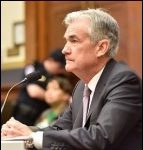
By Pam Martens and Russ Martens: March 13, 2020 ~ The Federal Reserve Board of Governors has acknowledged to Wall Street On Parade that it has 233 documents that might shed some light on why JPMorgan Chase was allowed by the Fed to draw down $158 billion of the reserves it held at the Fed last year, creating a liquidity crisis in the overnight loan market according to sources on Wall Street. After taking four months to respond to what should have been a 20-business day turnaround on our Freedom of Information Act request, the Federal Reserve denied our FOIA in its entirety. (Our earlier request to the New York Fed resulted in the same kind of stonewalling. See The New York Fed Is Keeping JPMorgan’s Secrets Close to Its Chest.) The Wall Street liquidity crisis forced the Federal Reserve, beginning on September 17 of last year, to begin making … Continue reading
Two Charts Explain Why Wall Street Banks Are Under So Much Selling Pressure
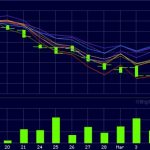
By Pam Martens and Russ Martens: March 6, 2020 ~ Yesterday, the Dow Jones Industrial Average of 30 large cap companies closed with a loss of 969.5 points or 3.58 percent. That was bad enough but the losses among the biggest Wall Street banks outpaced the Dow losses by a significant margin. Typically, JPMorgan Chase is one of the better performers among the Wall Street banks in the midst of a big selloff. But not yesterday. It closed with a loss of 4.91 percent – a loss larger than Goldman Sachs (- 4.77 percent), which has a large criminal fine hanging over its head. The news that Jamie Dimon, Chairman and CEO of JPMorgan Chase, had heart surgery on Thursday was not reported until after the stock market had closed. The losses among the other mega banks on Wall Street yesterday were equally unsettling. Morgan Stanley lost 5.86 percent; Citigroup … Continue reading
Fed Chair Powell Is a Member of a Private Club with a History of Racism and Sexism
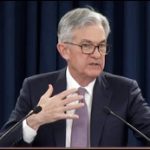
By Pam Martens and Russ Martens: February 14, 2020 ~ Congresswoman Katie Porter opened a hornet’s nest on Tuesday during a House Financial Services Committee hearing where Fed Chair Jerome Powell answered questions. As we reported, Porter held up a photo of Powell in black tie attending a lavish party for billionaires and politicians at the Washington D.C. home of one of the richest men in the world, Amazon CEO Jeff Bezos. As it turns out, that wasn’t even the worst part of the story. The real jaw dropper is that the Bezos party was the after-party for a secretive private club’s annual dinner. The so-called Alfalfa Club is a 107-year old, invitation-only club that bars the press from attendance and banned membership of blacks and women for the bulk of its existence. Fed Chair Powell is a member of that club. More on that shortly, but first some background. … Continue reading
JPMorgan Chase Is Under Fourth Criminal Probe after Pleading Guilty to Three Prior Felony Counts

By Pam Martens and Russ Martens: February 6, 2020 ~ Yesterday, Bloomberg News reporters Tom Schoenberg and Liam Vaughan broke the story that JPMorgan Chase is under a criminal probe by the U.S. Department of Justice (DOJ) over charges of rigging gold, silver and other precious metals markets. Six traders who worked on the precious metals desk at JPMorgan Chase have been indicted thus far but this is the first report that the bank itself is also under a criminal investigation. This marks the fourth criminal probe of the bank in the past 8 years by the U.S. Department of Justice with the bank pleading guilty to three felony counts in two of the prior criminal investigations. Throughout this serial crime wave, the Board of Directors of JPMorgan Chase has kept Jamie Dimon in his seat as Chairman and CEO. Despite knowing that three of the bank’s traders had been … Continue reading
JPMorgan’s Historic Earnings Confirm that Fed Loans Are Subsidizing Profits on Wall Street

By Pam Martens and Russ Martens: January 15, 2020 ~ The New York Fed is back to subsidizing billions of dollars in profits at Wall Street’s trading houses, just as it did during the financial crisis. Yesterday, JPMorgan Chase reported that its profits for the quarter ending December 31, 2019 hit an all-time record. (The bank has been around for more than a century, so that’s saying something.) The quarterly profits were $8.52 billion – for the same three-month period in which the New York Fed has been flooding unnamed Wall Street trading houses with hundreds of billions of dollars each week in super cheap loans. The so-called “repo loans” by the New York Fed are being made at a fraction of where the free market would price loans to these Wall Street trading houses. On September 17, 2019, the first day the Fed began this open money spigot to … Continue reading
Both Boeing and the New York Fed Have Been Hiding Dangerous Truths from the American People
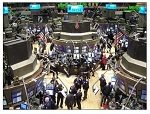
By Pam Martens and Russ Martens: January 10, 2020 ~ The design of the Boeing 737 Max and the Wall Street banking system are both dangerously flawed. The 737 Max has been grounded for almost 10 months following two airline crashes that killed 346 people. The Wall Street banking system, which crashed in 2008 and spread its wreckage into the lives of millions of Americans with job losses, home foreclosures, and trillions of dollars in lost savings is still being allowed to operate on a wing and a prayer. In the case of the Boeing 737 Max, Congress did not know beforehand that dangerous problems existed. In the case of the Wall Street banking system, Congress has had repeated warnings since 2012 of systemic dangers that it has simply chosen to ignore under heavy Wall Street lobbying pressure and the allure of tens of millions of dollars in political campaign … Continue reading

